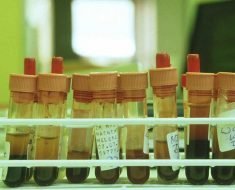Covid-19: Sir Patrick Vallance warns 'virus hasn't gone away'
We use your sign-up to provide content in ways you’ve consented to and to improve our understanding of you. This may include adverts from us and 3rd parties based on our understanding. You can unsubscribe at any time. More info
For most people, Covid results in a mild illness, with cold-like symptoms surfacing in the first few days of infection. However, Covid has been shown to cause lingering effects in some people, some of which greatly undermine quality of life. Now experts have warned there is a greater chance of a “bleeding event” in the two months after falling ill.
Researchers from Sweden discovered there is a risk of developing a range of blood vessel complications following Covid infection.
These include a greater risk of deep vein thrombosis up to three months post-infection and of a blood clot in the lung up to six months later.
The startling discovery underscores the importance of getting vaccinated: the protective benefits extend beyond the risks posed by the initial infection.
The experts found even mild non-hospitalised Covid patients were at risk of deep vein thrombosis (DVT) and pulmonary embolism.

DVT is a condition in which a blood clot develops in the deep veins, most commonly in the lower extremities.
A pulmonary embolism occurs when a part of the clot breaks off and travels to the lungs, a potential life threat.
“Our findings arguably support thromboprophylaxis to avoid thrombotic events, especially for high risk patients, and strengthen the importance of vaccination against COVID-19,” they concluded.
The chances of getting a blood clot were found to be higher in the first wave of the pandemic.
This suggests improvements in treatment and wide-ranging vaccine coverage mitigated the impact.
In a linked editorial, researchers at the University of Glasgow looked into the prospect of many governments removing restrictions and shifting their focus to “living with Covid”.
They added this study “reminds us of the need to remain vigilant to the complications associated with even mild SARS-CoV-2 infection, including thromboembolism”.
It is thought there is a higher risk of blood clots post Covid due to the massive inflammatory response that can happen in some patients.

DVT – what to look for
Symptoms of DVT in the leg are:
- Throbbing or cramping pain in one leg (rarely both legs), usually in the calf or thigh
- Swelling in one leg (rarely both legs)
- Warm skin around the painful area
- Red or darkened skin around the painful area
- Swollen veins that are hard or sore when you touch them.
“These symptoms can also happen in your arm or tummy if that’s where the blood clot is,” explains the NHS.
According to the NHS, you should call 999 or go to A&E if you have symptoms of DVT, such as pain, swelling, breathlessness and chest pain.
“DVT can be very serious because blood clots in your veins can break loose, travel through your bloodstream and get stuck in your lungs.”
Source: Read Full Article





